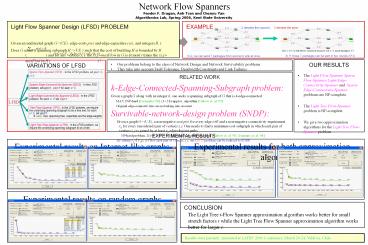Feodor F. Dragan, Anh Tran and Chenyu Yan PowerPoint PPT Presentation
Title: Feodor F. Dragan, Anh Tran and Chenyu Yan
1
Network Flow Spanners
- Feodor F. Dragan, Anh Tran and Chenyu Yan
- Algorithmics Lab, Spring 2006, Kent State
University
EXAMPLE 2 denotes the capacity
3 denotes the price
In H, those 7 packages can be sent in two rounds
(52)
In G, we can send 7 packages from source to sink
at once
- OUR RESULTS
- The Light Flow-Spanner, Sparse Flow-Spanner,
Light-Edge-Connectivity-Spanner and Sparse
Edge-Connectivity-Spanner problems are
NP-complete. - The Light Tree Flow-Spanner problem is
NP-complete. - We give two approximation algorithms for the
Light Tree Flow-Spanner problem
- Our problems belong to the class of Network
Design and Network Survivability problems - They take into account Fault Tolerance, Bandwidth
Constraints and Link Failures
VARIATIONS OF LFSD
- RELATED WORK
- k-Edge-Connected-Spanning-Subgraph problem
- Given a graph G along with an integer k, one
seeks a spanning subgraph of G that is
k-edge-connected - MAX SNP-hard Fernandes98, (12/k)-approx.
algorithm Gabow et. al.05 - Original edge-connectivities are not taking into
account - Survivable-network-design problem (SNDP)
- Given a graph G(V, E), a non-negative cost p(e)
for every edge e?E and a non-negative
connectivity requirement rij for every
(unordered) pair of vertices i, j. One needs to
find a minimum-cost subgraph in which each pair
of vertices i, j is joined by at least rij
edge-disjoint paths. - NP-hard problem, 2(11/21/31/k)-approximation
algorithm Gabow et. al.98, Goemans et. al.94 - By setting rij?FG(i, j)/t? for each pair of
vertices i, j, our LECS problem can be reduced to
SNDP.
EXPERIMENTAL RESULTS
Experimental results for both approximation
algorithms
Experimental results on Internet-like graphs
Experimental results on random graphs
CONCLUSION The Light Tree t-Flow Spanner
approximation algorithm works better for small
stretch factors t while the Light Tree Flow
Spanner approximation algorithm works better for
larger t.
Results were partially presented at LATIN 2006
Conference, March 20-24, Valdivia, Chile
PowerShow.com is a leading presentation sharing website. It has millions of presentations already uploaded and available with 1,000s more being uploaded by its users every day. Whatever your area of interest, here you’ll be able to find and view presentations you’ll love and possibly download. And, best of all, it is completely free and easy to use.
You might even have a presentation you’d like to share with others. If so, just upload it to PowerShow.com. We’ll convert it to an HTML5 slideshow that includes all the media types you’ve already added: audio, video, music, pictures, animations and transition effects. Then you can share it with your target audience as well as PowerShow.com’s millions of monthly visitors. And, again, it’s all free.
About the Developers
PowerShow.com is brought to you by CrystalGraphics, the award-winning developer and market-leading publisher of rich-media enhancement products for presentations. Our product offerings include millions of PowerPoint templates, diagrams, animated 3D characters and more.

